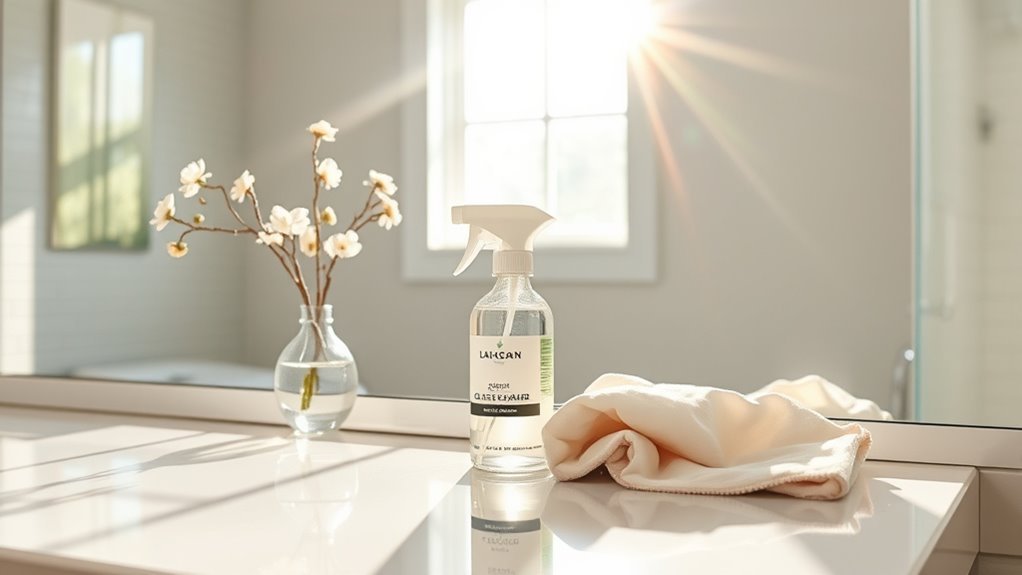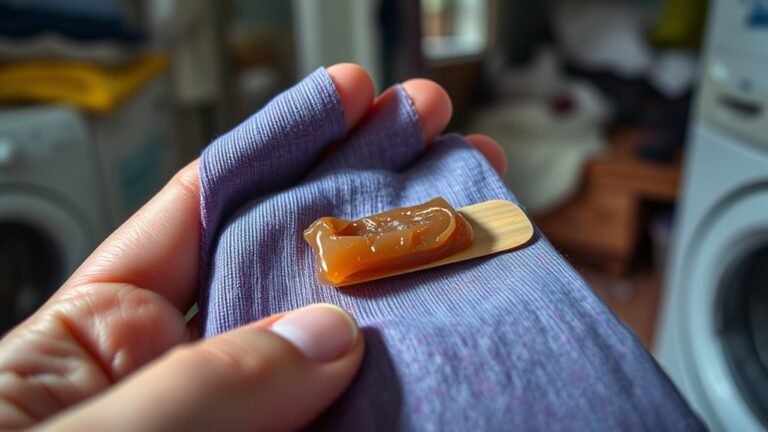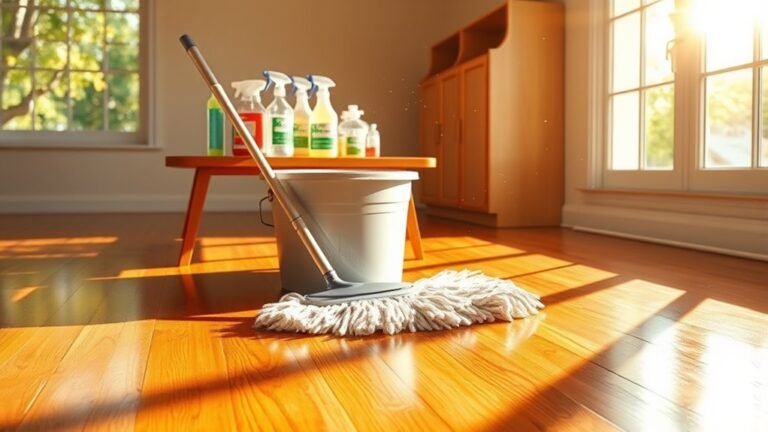Spring Cleaning Guide for Mirror
For your spring mirror cleaning, start with a soft microfiber cloth and a gentle cleaner like a vinegar-water mix. Lightly dust the mirror, spray your solution evenly avoiding excess moisture, and wipe in circular motions. For stubborn spots, try rubbing alcohol and finish with vertical strokes to prevent streaks. Maintain your mirror by wiping it daily and using a squeegee after showers. Keep going to find simple tips and natural solutions that make the job even easier.
Essential Tools and Materials for Mirror Cleaning

Before you plunge into cleaning your mirror, gathering the right tools and materials will make the job much easier. Depending on your mirror types—whether framed, beveled, or simple glass—you’ll want a few essentials on hand. Grab a soft microfiber cloth to prevent scratches and a gentle glass cleaner or a mix of vinegar and water for an eco-friendly option. Avoid abrasive sponges or harsh chemicals that can damage delicate surfaces. Consider a lint-free cloth for drying to keep streaks at bay. Your cleaning frequency matters too; mirrors in humid areas may need weekly attention, while others can wait longer. Being prepared with the right tools lets you clean efficiently, giving you more freedom to enjoy your sparkling reflections without fuss or frustration.
Step-by-Step Mirror Cleaning Process
Now that you have your tools ready, it’s time to clean your mirror effectively. Start by lightly dusting the surface to remove loose particles—this simple step prevents scratching during mirror maintenance. Next, spray your chosen cleaning solution evenly, avoiding excess moisture that can damage edges. Use a microfiber cloth in gentle, circular motions to wipe the mirror, focusing on one section at a time. Make sure to flip or switch cloths when they get damp to avoid streaks. Pay attention to cleaning frequency; regular upkeep, about once a week, keeps your mirror sparkling and prolongs its lifespan. By following these straightforward steps, you’ll enjoy a clear reflection without hassle, giving you more freedom to focus on what truly matters.
Tips for Removing Stubborn Streaks and Spots

Wondering how to tackle those stubborn streaks and spots that just won’t budge? Don’t let them hold you back from enjoying a perfectly clean mirror. Here are some streak free techniques to help you break free from mirror cleaning myths and get that crystal-clear shine:
- Use a microfiber cloth instead of paper towels—this reduces lint and streaks.
- Apply a small amount of rubbing alcohol on tough spots, then wipe gently to lift residues without smearing.
- Always wipe in a circular motion, finishing with vertical strokes to banish streaks completely.
Natural and Homemade Cleaning Solutions
If you’re looking to skip harsh chemicals while still getting your mirror spotless, natural and homemade cleaning solutions can be a great alternative. You can easily mix a vinegar solution by combining equal parts white vinegar and water in a spray bottle. This simple blend cuts through grime and leaves your mirror streak-free. For a fresh twist, add a splash of lemon juice—it boosts cleaning power and leaves a pleasant scent. Just spray your solution onto the mirror, wipe with a microfiber cloth or newspaper, and watch the shine return. These natural options give you the freedom to clean safely and effectively without relying on commercial products. Plus, they’re budget-friendly and eco-conscious, helping you keep your space bright and fresh the natural way.
Maintaining Sparkling Mirrors Between Cleanings

Although regular deep cleaning is essential, maintaining your mirror’s sparkle between sessions is just as important to keep it looking pristine. To help you embrace freedom from constant grime, here are some effective mirror maintenance tips for daily upkeep:
- Wipe with a microfiber cloth daily: This prevents dust and smudges from building up without scratching the surface.
- Use a squeegee after showers: Moisture causes streaks and spots, so a quick swipe keeps your mirror crystal clear.
- Avoid touching the glass with bare hands: Oils from your skin leave marks that dull the shine, so use a cloth if you need to adjust or clean.
With these simple daily upkeep habits, your mirror will stay sparkling and ready without extra effort.
Frequently Asked Questions
Can I Use Vinegar on Antique Mirrors?
When wondering whether vinegar works well with your wonderful, weathered antique mirror, you should tread thoughtfully. Vinegar’s acidity can damage delicate surfaces, so it’s best to avoid it for antique mirror care. Instead, consider gentle vinegar alternatives like diluted dish soap mixed with warm water or specialized glass cleaners made for vintage pieces. You deserve freedom in your cleaning choices, but protecting your prized mirror’s patina is paramount. Always test first!
How Often Should Bathroom Mirrors Be Deep Cleaned?
You should aim for a cleaning frequency of deep cleaning your bathroom mirrors about once a month to keep them sparkling and free from stubborn grime. Regular mirror maintenance, like wiping down with a gentle cleaner weekly, helps you avoid buildup and keeps your space feeling fresh and open. By sticking to this routine, you’ll enjoy the freedom of a clear reflection without the hassle of tough, time-consuming cleans later on.
Are There Special Cleaners for Fog-Resistant Mirrors?
Imagine your fog-resistant mirror as a brave knight, standing tall against the steamy dragons of your bathroom. To keep that knight shining and clear, you’ll want fog resistant solutions specially formulated for mirror maintenance. These cleaners create a protective shield, preventing fog from settling and ensuring your reflection stays crisp and free. Using regular glass cleaners won’t cut it; invest in these specialized products to enjoy your mirror’s full, fog-free freedom every day.
Can Mirror Frames Be Cleaned With the Same Solutions?
You might think you can use the same cleaners for mirror frames, but it really depends on the frame materials. Wood, metal, or plastic each need different cleaning techniques to avoid damage. For instance, wood frames benefit from gentle dusting and mild polish, while metal frames can handle a slightly stronger cleaner. So, it’s best to tailor your approach to keep your frames looking fresh without risking harm.
What Causes Mirror Edges to Blacken Over Time?
You might notice mirror edges blackening over time because of mirror deterioration. This usually happens when moisture seeps into the silver backing, causing it to oxidize and break down. The blackening causes can also include exposure to cleaning chemicals or humidity. To keep your mirrors looking fresh, avoid harsh cleaners near the edges and try to keep the area dry. That way, you’ll enjoy a clear reflection without worrying about damage.






